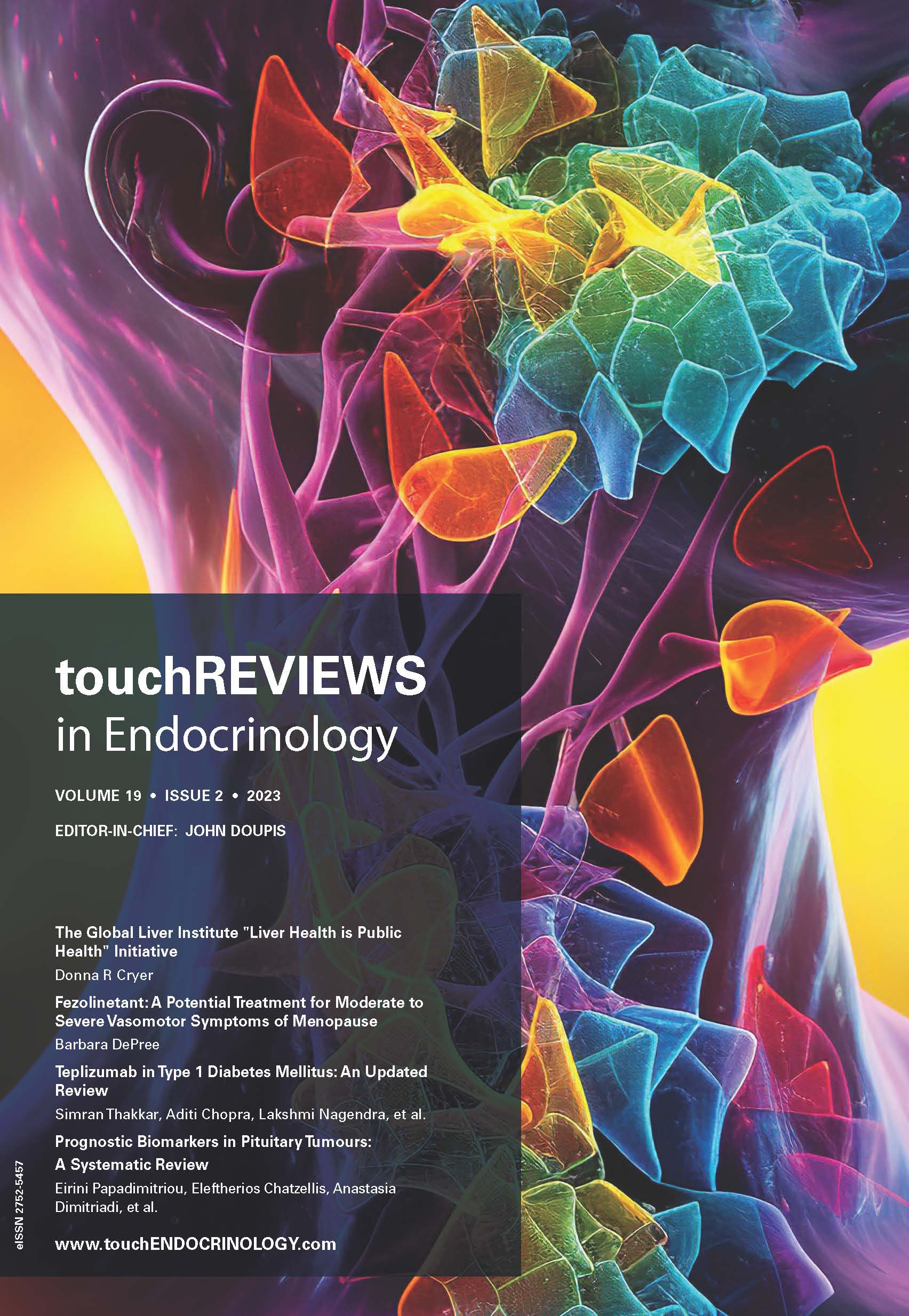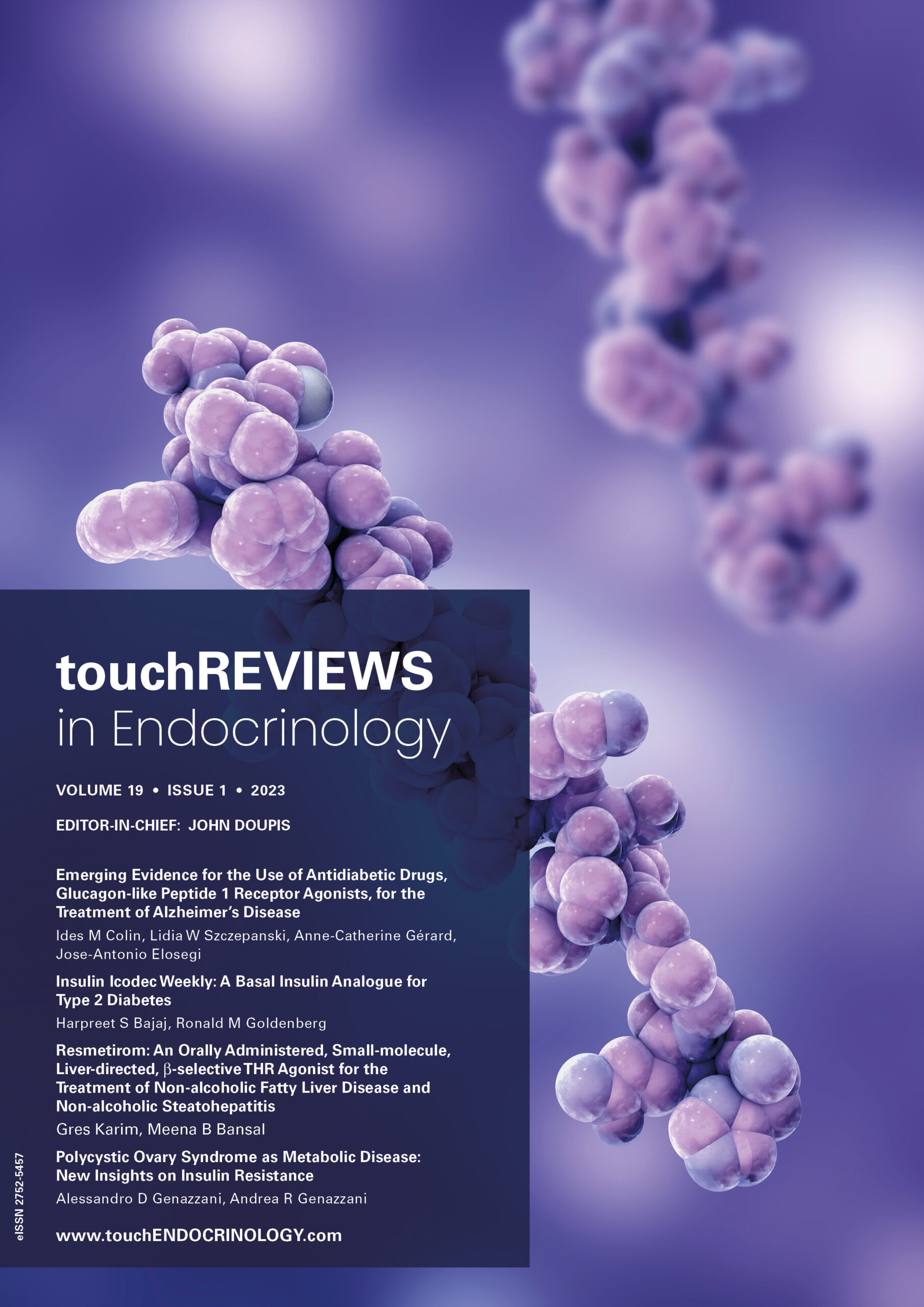touchREVIEWS in Endocrinology Volume 20, Issue 1, 2024
Welcome to the latest edition of touchREVIEWS in Endocrinology. This free-to-access issue covers a range of important topics including diabetes, obesity, pituitary disorders, thyroid disorders, liver disorders and endocrine oncology.
We would like to take this opportunity to thank all who contributed towards this edition, in particular our authors, Editor-in-Chief, editorial board members and partners.
Enjoy and happy reading!
Foreword
Welcome to the latest edition of touchREVIEWS in Endocrinology, which features a range of review, case report and original research articles that highlight some key developments in our understanding and management of endocrinological disease. We begin with a commentary from Eleni Armeni and Ashley Grossman on seliciclib, a potential new treatment for patients with Cushing’s […]
Erratum
Commentary
Cushing’s disease (CD), or pituitary-dependent Cushing’s syndrome, is almost always caused by corticotroph tumours, a type of pituitary neuroendocrine tumour, which overproduces adrenocorticotrophic hormone (ACTH), ultimately leading to hypercortisolism and its associated clinical consequences, including increased mortality.1 The complications associated with Cushing’s syndrome must be minimized through effective treatment, ideally by rapidly normalizing hypercortisolaemia.1 The most effective […]
Editorial
There has been an exponential increase in the global prevalence of obesity over the past few decades because of adverse lifestyle choices, such as physical inactivity and overconsumption of macronutrients. The obesity pandemic has contributed to more than 50 different disorders related to excess body weight, which has substantially increased morbidity and mortality worldwide.1 Metabolic syndrome […]
Reviews
Gestational diabetes mellitus (GDM) is generally defined as “any degree of glucose tolerance with onset or first recognition during pregnancy”.1 It currently is one of the diseases with the highest morbidity among pregnant women.2 Determining its prevalence has been a real challenge for the scientific community due to multiple modifications in the diagnostic criteria established in 1964 […]
Type 2 diabetes (T2D) is one of the most common chronic noncommunicable diseases, its incidence is exponentially increasing and is one of the leading causes of morbidity and mortality worldwide.1 As of 2021, T2D ranked among the top causes of premature death and was responsible for more than 6.5 million deaths.2 Currently, approximately 537 million people (over […]
Periodontitis is a chronic inflammatory disease of the periodontium, or the supportive tissues around the tooth, which includes the gingival tissue, alveolar bone, cementum and the periodontal ligament.1 Caused by pathogenic bacteria, this disease has been recognized for at least 5,000 years and has been related to diverse risk factors, such as the presence of plaque […]
Acromegaly is the clinical consequence of chronic excessive exposure of the tissues to growth hormone (GH) and its second messenger, insulin-like growth factor-I (IGF-I). The excess GH secretion is almost exclusively secondary to a GH-secreting pituitary adenoma (somatotropinomas); however, excess GH also results from ectopic GH-releasing hormone (GHRH) secretion, usually from a neuroendocrine tumour, in […]
Acromegaly is a chronic disease caused by an excess of growth hormone (GH) and insulin-like growth factor 1 (IGF-1).1,2 Besides facial and acral changes, systemic complications lead to decreased quality of life and survival rates.3 The primary goal of acromegaly treatment is to normalize biochemical parameters, which significantly reduces the risks of complications and comorbidities associated with […]
Osilodrostat, a novel potent oral steroidogenesis inhibitor, has recently been approved for the treatment of adult patients with endogenous Cushing’s syndrome (CS), and Cushing’s disease (CD) not cured by pituitary surgery or in whom pituitary surgery is not an option. Osilodrostat acts by inhibiting the adrenal enzymes 11-beta-hydroxylase and aldosterone synthase, and by inducing the […]
Original Research
Despite the increasing body of knowledge of treatment strategies for diabetes, many patients with type 2 diabetes mellitus (T2DM) are still in a persistent state of poor glycaemia.1,2 In clinical practice, achieving optimal glycaemic targets is challenging; the reasons are complex, as both patient- and healthcare provider (HCP)-related factors can play a significant role.3,4 When lifestyle […]
In the USA, neck ultrasound (US) identifies thyroid nodules (TNs) in 30–50% of adult patients.1,2 Given that the risk of malignancy (ROM) for all combined thyroid nodule types ranges from 5% to 15%,2,3 current guidelines recommend US of the neck initially, to identify suspected TNs.4 Neck US is used to localize TNs, facilitate risk stratification, clarify the necessity […]
Case Report
Burkitt lymphoma (BL) is a non-Hodgkin B-cell lymphoma originating from the germinal center, characterized by dysregulation of the MYC gene, often resulting from the translocation of chromosome 8 into 14. It is extremely aggressive, representing the fastest proliferating cancer, and typically involves the lymph nodes, bone marrow and the central nervous system.1,2 Three identifiable subtypes include sporadic, endemic, […]

Trending Topic
Thyroid nodules are common worldwide, and their prevalence is increasing. Most nodules are asymptomatic and detected incidentally on cross-sectional imaging or physical examination. In rare cases (10–15%), nodules are malignant and require diagnostic evaluation. Even malignant nodules frequently show non-aggressive behaviour.1 The increase in the incidence of thyroid cancer is unfairly distributed globally, and the […]
Journal Archive
touchREVIEWS in Endocrinology (previously European Endocrinology) is a peer-reviewed, free-to-access, bi-annual journal comprising review articles, case reports, editorials, special reports and original research. It features balanced and comprehensive articles written by leading authorities, addressing the most important and salient developments in the field of endocrinology.
Latest articles videos and clinical updates - straight to your inbox
Log into your Touch Account
Earn and track your CME credits on the go, save articles for later, and follow the latest congress coverage.
Register now for FREE Access
Register for free to hear about the latest expert-led education, peer-reviewed articles, conference highlights, and innovative CME activities.
Sign up with an Email
Or use a Social Account.
This Functionality is for
Members Only
Explore the latest in medical education and stay current in your field. Create a free account to track your learning.


















